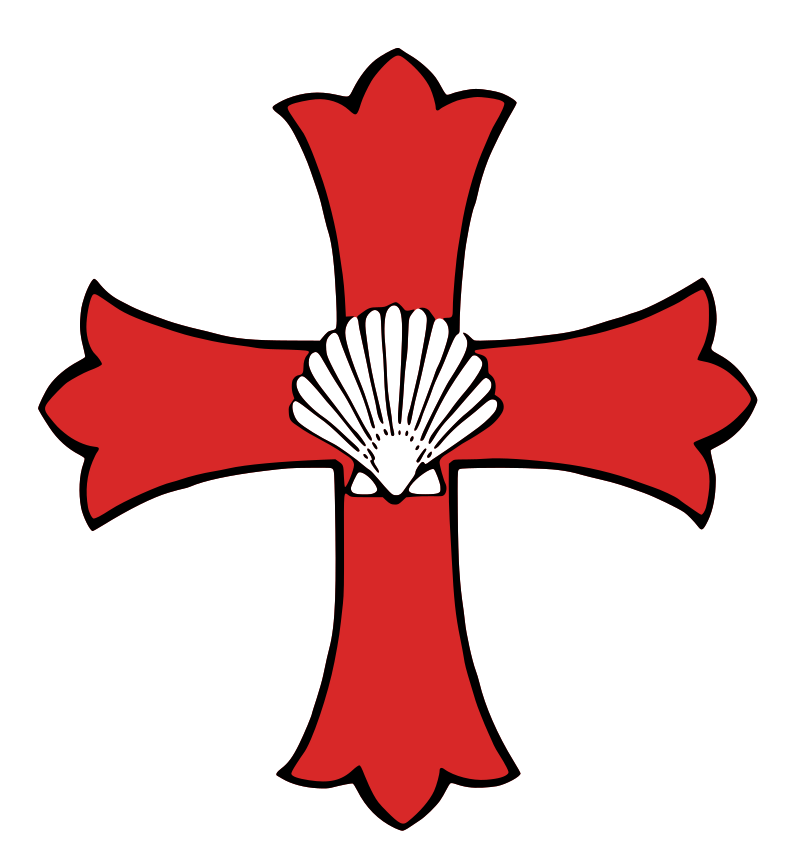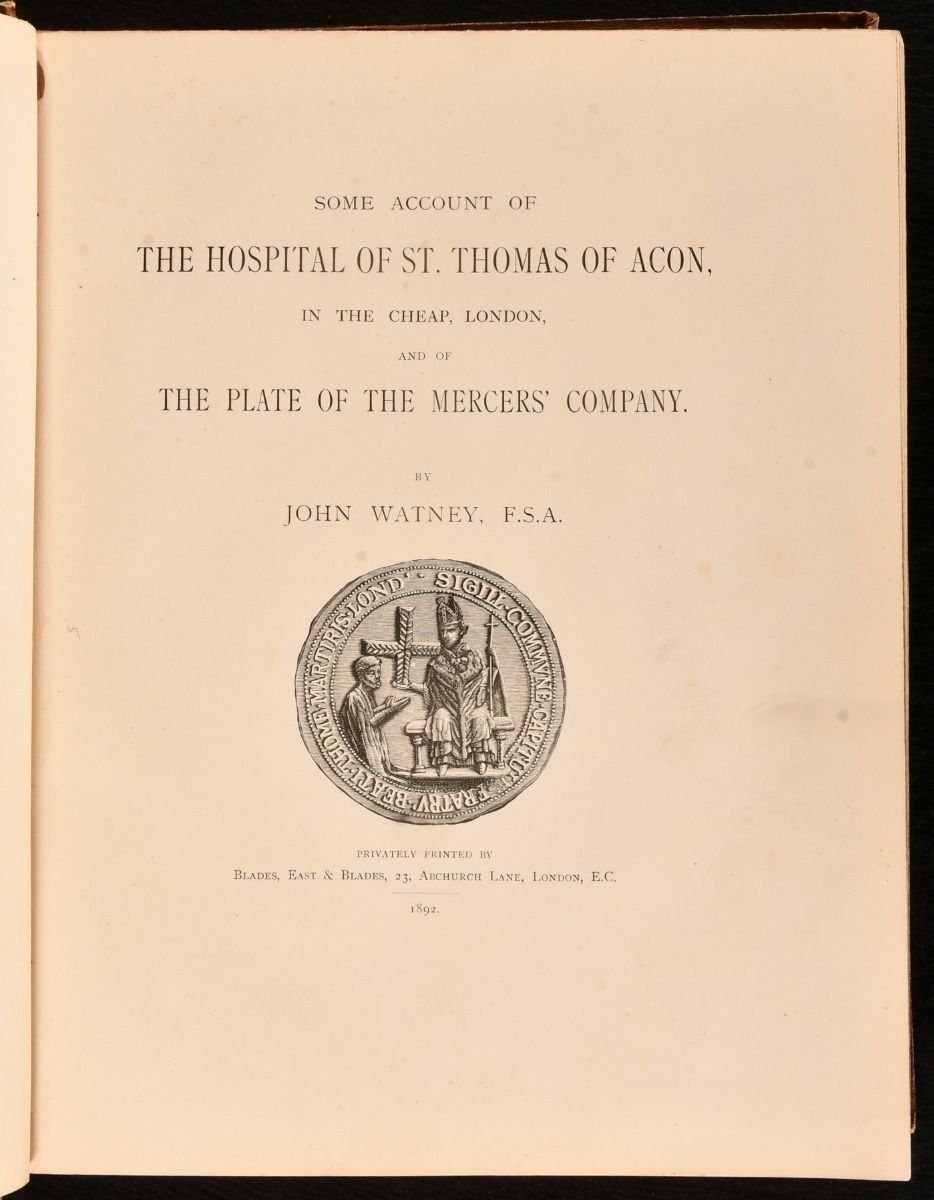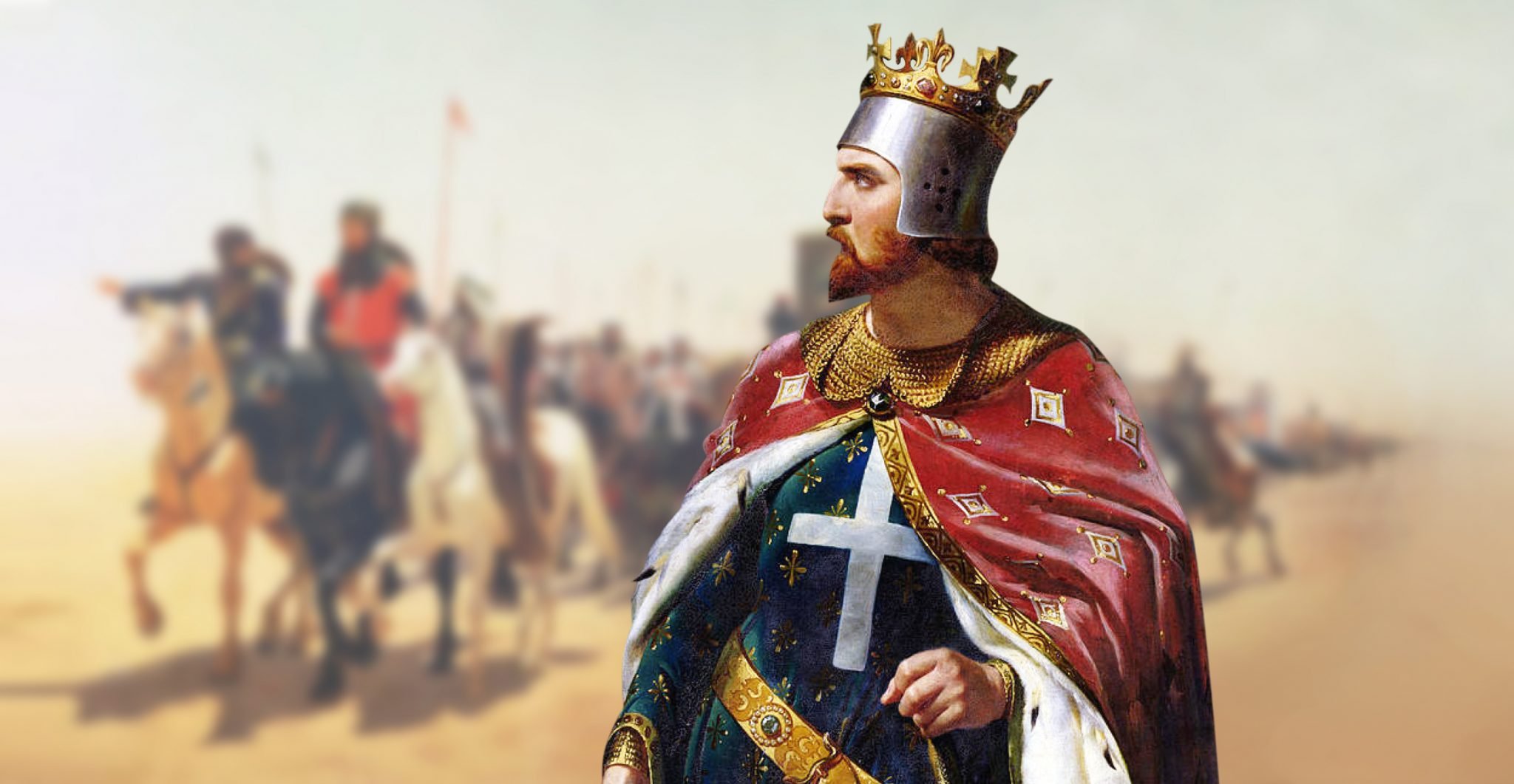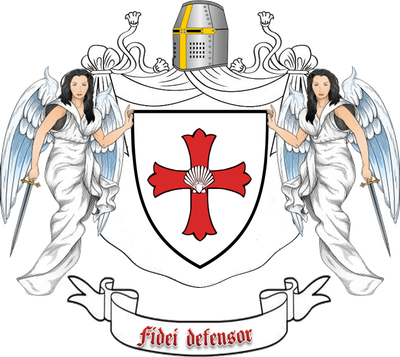Militae Hospitalis St. Thomae Martyris Cantuariensis
During the Third Crusade (1189-1192), there was a group of knights who decided to establish a new order of chivalry in honour of Saint Thomas Becket, the martyred archbishop of Canterbury. The Order of Knights of St. Thomas of Canterbury was founded by William, a chaplain to Ralph of Diceto, with the possible involvement of Hubert Walter, archbishop of Canterbury, and King Richard I of England. In the “Theatre of Honour” lib. 9, cap. 11, the author, in giving an account of the military orders of the Holy Land, says:
“The order of St. Thomas was instituted by the King of England, Richard, surnamed Catur de Lyon, after the surprizal of Acars and being of the English nation they held the rule of St. Augustin , and wore a white habit and a full red cross, charged with white scallop in middle”
The chronicle of the Teutonic Knights. in relating the capture of Acre, in 1191, places the Knights of St. Thomas at the head of the 5000 men, whom the king of England sent into the Holy Land, and Herman Corner, writing a century later, mentions them among the defenders of Acre.

Matthew Paris an english Benedictine monk, chronicler, artist in illuminated manuscripts, and cartographer, asserts in the Historia Anglorum, that the knights were originally seculars, but that the order was re-modelled and affiliated to the Templars by Peter de Rupibus, Bishop of Winchester, during his visit to the Holy Land about the year 1230. He also says that Richard I on his expedition to the Holy Land in 1190, being overtaken by a storm in the Levant, was saved from shipwreck by the miraculous intervention of St. Thomas, who appeared to him and promised that he should come safely to land. He goes on to say that many citizens of London, who were on board shipin the following year when Acre was taken, founded a hospital there. The same story can be found in the chronicles of Roger of Hoveden and Roger of Wendover, St. Thomas Becket appeared in a vision to three Londoners, including William FitzOsbert and Geoffrey Aurifaber, on the ‘London ship’. He promised them that he, St Edmund, and St Nicholas, arguably the three most popular male saints in late-12th century England, were protecting the entire English fleet.
Ralph de Diceto, dean of St Paul’s Cathedral, wrote that his chaplain William fulfilled a vow to St Thomas to found a chapel in Acre as thanks for safe transport over the seas. This was the start of the ‘Order of St Thomas of Acre’ established in Acre in 1191 with the backing of King Richard the Lionheart. In the Decem Scriptores we read that:
“When the City of Acars or Acon, in the Holy Land (called also Ptolemais), was besieged by the Christians, one William, an English man by nation, being chaplain to Radulphus de Diceto, Dean of London, when he went to Jerusalem bound himself by a vow that if he should prosperously enter Acon he would build a chapel to St Thomas the Martyr at his own charge, according to his ability, and would procure there, to the honour of the said martyr, a churchyard to be consecrated, which was done. Then many flocking from all parts to serve in this chapel, William himself, as a token of his Christianity, took on him name of Prior, who, whilst he served bodily as a soldier of Christ, had an especial care of the poor; and he freely bestowed all his diligence and labour in the burying of the bodies of such as died, as well natural y, as of others who were slain with the sword."

According Sir John Watney in his book SOME ACCOUNT OF THE HOSPITAL OF ST. THOMAS OF ACON from 1892 , the great abbey of St. Thomas the Martyr in Dublin said to have belonged, originally, to the order of the Knights of St. Thomas; it, however, afterwards became a house of Augustinian canons of the order of St. Victor. Gilbert Marshal l, Earl of Pembroke, made a grant of lands in Kilkenny, in Ireland, to the knights and brethren of the house of St. Thomas the Martyr of Acon, and also to the house of St. John the Baptist at Kilkenny. This grant, and one from Fulk de Villars to the same knights and brethren, dated May, 1219, of a carucate of land, with a fit and convenient place at Pinam for building a church and houses there, and timber from the wood at Gressey, sufficient for building the church and house, for cooking and other uses, also the site of his mill at Dignac, which they had built, or were about to build, and of which he and his heirs possessed the half and they possessed the other half, and also common of pasture in wood and meadow for their greater and lesser beasts; and also a grant from Edmund Bret, Lord of Karikmagriffyn, to the knights and brethren of the same house, living at St. John in Karikmagriffyn, of all his right and claim to tenements in Karikmagriffyn, were confirmed by King Edward I , by charter dated at Westminster on the 5th June, in his 17th year, 1287, in consideration of a fine of five marks.
It never had more than four houses, and its operations in the Holy Land were hindered by their poverty. The most important house of the order was that founded in London in the 1220s, on the site of Thomas Becket’s birth. Bishop Tanner, in his Notitia, quoted in Dugdale’s Monasticon, vol. VI, p. 645, gives the following account of this hospital. He says: "On the north side of Cheapside, London, in the parish of St Mary Colechurch, was founded by Thomas Fitz Theobald de Helles, and Agnes his wife, sister to Thomas Becket, Archbishop of Canterbury, in the latter end of the reign of King Henry the II, an hospital to the honour of the Blessed Virgin and the said Archbishop, now styled Saint and Martyr. It was built upon houses and lands formerly belonging to Gilbert Becket, father to the Archbishop, and where in his famous son was born. This hospital consisted of a Master and several Brethren, professing the rule of St. Augustin, but were of a particular order which was about this time instituted in the Holy Land, Militae Hospitalis St. Thomae Martyris Cantuariensis de Acon, being a branch of the Templars.”
The order originally consisted of a chapel served by Augustinian canons, and performed charitable and devotional duties, including hospital and ransom work. However, by 1228, the order was militarized by Peter of Roches, bishop of Winchester. In 1236, Pope Gregory IX instructed the order to follow the Rule of the Teutonic Order and carry out both military and hospitaller functions.
Pope Innocent IV, by letter dated 18th June, 1248 from Lyons, to the Fulke Basset, Bishop of London, gave permission to the master and brethren of the house of the knights of St. Thomas the Martyr of Acon, residing in England, to erect a chapel near their house for the sole use of the brethren.
Mas Latrie, in his history of the island of Cyprus under the house of Lusignan, prints from the archives in the Tower of London, a letter from King Edward I commending Ralph de Coumbe, the master and the brethren of the hospital and church of Acre, founded in honour of St. Thomas, to the good offices of Hugh Ill, King of Cyprus and Jerusalem. This letter was probably written in the year 1279, as it was answered from Acre on the 15th September, 1279, by Robert de Cardolio (Carlisle, who appears to have been the master of the hospital at Acre), and the brethren “of the poor hospital and church of Acre, built in honour of St. Thomas”. They said that the hospital owed its foundation (sumpsit exordium) to the ancestors of the king, that they had received with gratitude the king's cheering letter, from which they had understood that their poor house belonged not only to his ancestors, but was peculiarly his own, and that he would always render aid to it that Cyprus and Assyria (Syria) suffering from scarcity, they were in consequence much oppressed with poverty, and that the church of St. Thomas, though commenced long since, had not been finished. They therefore asked that the master of the order might be sent into Syria without delay, as the king’s poor house of Acre was suffering great damage through his absence. They said further that the condit ion of the Holy Land was such that, at the instigation of the devil, a great war had broken out between the Count of Tripoli and the Templars, while there were such dissensions among the Saracens that, with a little help, it would be possible entirely to destroy them.

Despite being small and not powerful enough to play a significant role in the affairs of Outremer, the Knights of St. Thomas acquitted themselves well in battle and sometimes became involved in political squabbles in the Latin East. Most of their holdings were concentrated in England, but they faced a constant battle for resources, partly because Englishmen often turned to the Hospitallers or Templars instead.
After the fall of Acre in 1291, the order retreated to Cyprus and established its headquarters there.
Some inscriptions can be found in the archives of Cyprus, that on the 30th August, 1344, Robert de Kendall, knight, preceptor general of the whole order of the Knights of St. Thomas the Martyr, in the kingdoms of Cyprus, Apulia, Sicily, Calabria, Brundusium, England, Flanders, Brabant, Scotland, Wales, Ireland, Cornwall, etc. and of all the houses in other kingdoms in divers parts of the world subject to the same order, and the brethren thereof appointed Sir Henry de Colchester and William de Brunvill to collect money for the order for the defence of the Holy Land against the enemies of the Catholic Faith and blasphemers, the appointment being dated from Nicosia, in the house of Guddefrid, archdeacon and canon of the church of Famagosta, and vicar “ in spiritualibus” of Philip, Arch-bishop of Nicosia.
Tensions arose between the military brethren in the East and the members of the order in England, who prioritized hospitaller activities. The English chapter ultimately won out, and the order abandoned its military function in the late fourteenth century, concentrating on charitable and devotional activities in England.
The order became increasingly associated with the Mercers’ Company of London and reverted to following the Rule of St. Augustine. It even operated a grammar school in London. According the National Archives in the Parliament in 1447, a petition was presented by Master William Lycchefeld, parson of the church of Allhallows the Great, Master Gilbert, parson of St. Andrew's, Holborn, Master John Cole, parson of St. Peter on Cornhill, and John Neel, Master of the hospital of St. Thomas of Acon, parson of Colechurch, referring to the less number of grammar schools, and the great hurt thereby caused, stating that "for as much as the City of London is the common concourse of this land, where in is great multitude of young people, not only born and brought forth in the same city, but also of many other parts of this land, some for lack of school masters in their own country, for to be informed of grammar there, and some for the great alms of lords, merchants, and others, and which is in London more abundantly done than in others places of this realm."
However, in 1538, the order was dissolved on the order of King Henry VIII, and its property was confiscated by the Crown and purchased by the Mercers’ Company for £969. Today, the order's archive is split into three parts, located in the Mercers’ Company (London), the British Library and the Public Record Office.
